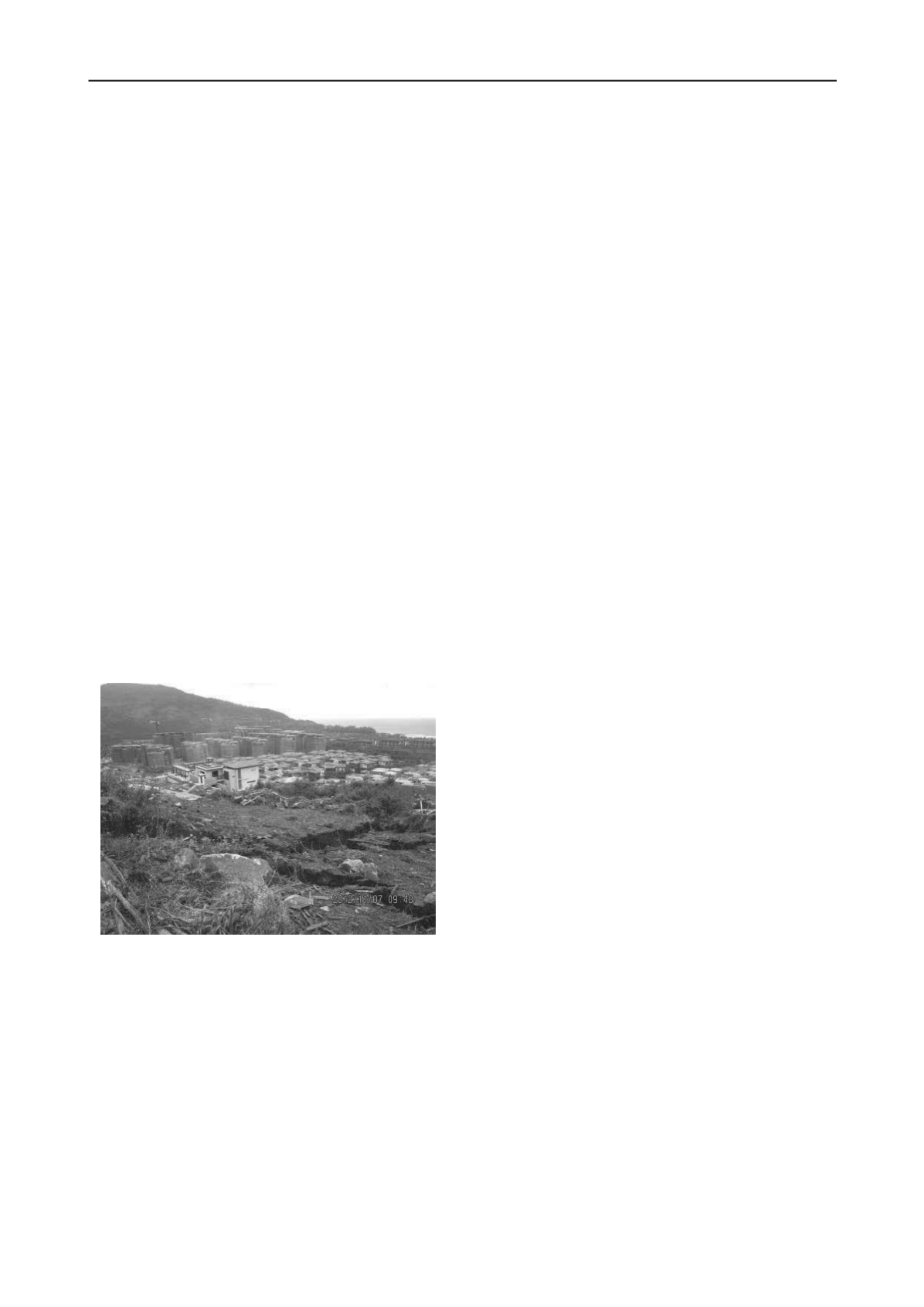
2208
Proceedings of the 18
th
International Conference on Soil Mechanics and Geotechnical Engineering, Paris 2013
5 THE FAILURE OF THE MONITORING SLIDING
SLOPE
As the client started the stabilization of the sliding slope using
man-dug piles and anchors, it was found that it was very
difficult to protect the monitored system. Therefore, automatic
monitoring system for the sliding slope has to be given up.
Instead, the sliding slope was being monitored manually during
the stabilization of the sliding slope.
There are several rows of piles needed to be constructed
during the stabilization and furthermore, there are a lot of
excavations before the stabilization. Though many warning
letters had been issued to the Contractor by the Consultant,
before the completion of the stabilization works, due to a heavy
rainfall on November 4, part of the sliding slope had completely
collapsed, which caused the fifth landslide for the site.
The investigation of the fifth landslides was carried out later.
It was found that the main reason for the landslide was the
improper excavation. Some of the excavation has an angle of 45
º
to 50
º
. As the Contractor believed that the wet season would
end and there would be no heavy rainfall in November 2012 just
as in November 2011, improper excavation was carried out for
the sliding slope.
Another very important reason for the failure of the improper
excavated sliding slope may be due to the significant increase of
the volumetric water content and the dramatic decrease of the
matric suction of the sliding slope. It may be proved that
negative pore-water pressure (or matric suction) plays a crucial
role in the stability of unsaturated soil slope. With rainfall
infiltration, the matric suction in soils at shallow depth would
partially or completely disappear. Consequently, a slope failure
may occur.
It is a pity that the automatic monitored system has to be
abandoned due to the construction.
Figure 5. Failure of the sliding slope during a heavy rainfall on
November 4, 2012.
6 CONCLUSIONS
From the study of the field monitoring of a monitoring sliding
slope in Hainan, China and the failure of the sliding slope at
last, the following conclusions can be made:
(1) The volumetric water content increased in the wet
season and decreased in the dry season. Correspondingly, the
matric suction decreased in the wet season and increased in the
dry season.
(2) The variations of the volumetric water content and
matric suction with time at different depths were different.
Maximum variations often occurred near the ground surface.
The large variations of volumetric water content and matric
suction during rainy season at shallow depth may explain the
reason why so many slope failures occurred in this region
during heavy rainstorms.
(3) The ground water level generally rose during the wet
season and fell during the dry season. The rise of the ground
water level occurred during heavy rainfall or long after the
rainfall. The ground water level also decreased temporarily after
the heavy rainfall.
(4) As the volumetric water content increased during the
rainfall, the monitored slope was sliding slowly, though
insignificantly.
Furthermore,
the monitored horizontal
displacement during the monitored period was not significant,
which is probably due to insignificant rise of the groundwater
level in the sliding slope.
(5) It is believed that the main reason for the failure of the
sliding slope was the improper excavation. It could also be due
to the loss of the matric suction, which plays a crucial role in
the stability of unsaturated soil slope.
7 ACKNOWLEDGEMENTS
The authors would like to thank China Resources Hainan
Shimei Bay Tourism & Development Co., Ltd. for their
providence of the site and especially their kind assistance during
the installation of the instruments and the monitoring of the
sliding slope in the field.
8 REFERENCES
Lumb, P. (1962a). General nature of the soils of Hong Kong, Proc.
Symp. Hong Kong Soils. Hong Kong, 19-32.
Lumb, P. (1962b). Effect of rainstorms on slope stability, Proc. Symp.
Hong Kong Soils. Hong Kong, 73-87.
Lumb, P. (1975). Slope failures in Hong Kong. Q. J. Engng Geol. 8, 31-
65.
Brand, E.W., Premchitt, J. & Phillipson, H.B. (1984). Relationship
between rainfall and landslides. Proceedings of the fourth
International Symposium on Landslides. Canada, 1, 377-384.
Au, S.W.C. (1998). Rain-induced slope instability in Hong Kong.
Engineering Geology. 51, 1-36.
Franks, C.A.M. (1999). Characteristics of some rainfall-induced
landslides on natural slopes, Lantau Island, Hong Kong. Quarterly
Journal of Engineering Geology. 32 247-259.
Dai, F.C., Lee, C.F., Wang, S.J., & Feng, Y.Y. (1999). Stress-strain
behavior of a loosely compacted volcanic-derived soil and its
significance to rainfall-induced fill slope failures. Engineering
Geology 53, 359-370.
Dai, F.C. & Lee, C.F. (2001). Frequency-volume relation and prediction
of rainfall-induced landslides. Engineering Geology 59, No. 3-4,
253-266.
Li, A.G., Yue, Z.Q., Tham, L.G., Lee, C.F. & Law, K.T. (2002).
Rainfall Infiltration at an Instrumented Cut Slope. 55th Canadian
Geotechnical Conference, October 20-23, 2002, Ontario, Canada,
1159-1167.
Li, A.G., Yue, Z.Q., Tham, L.G., Lee, C.F. & Law, K.T. (2003). Design
and Installation of a Comprehensive Instrumentation System for a
Slope in Hong Kong. Chinese Journal of Rock Mechanics and
Engineering, 22 No. 5, 790-796. (In Chinese)
Li, A.G., Yue, Z.Q., Tham, L.G., Lee, C.F. & Law, K.T. (2005a). Field
Monitored Variations of Soil Moisture and Matric Suction in a
Saprolite Slope. Canadian Geotechnical Journal. 42 13-26.
Li, A.G., Tham, L.G., Yue, Z.Q., Lee, C.F. & Law, K.T. (2005b). Field
Soil-Water Characteristics of Completely Decomposed Granite.
Journal of Geotechnical and Geoenvironmental Engineering. 131
No.9 1176-1180.
Li, A.G., Xiong, J.A., Nan, L. and Qiu, J. J. (2006). The Study of
Rainfall-Induced Sliding of a Fill Slope in Shenzhen, China, The
10th IAEG Congress, 6-10 September 2006, Nottingham, United
Kingdom.


